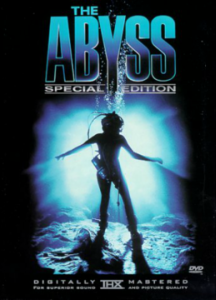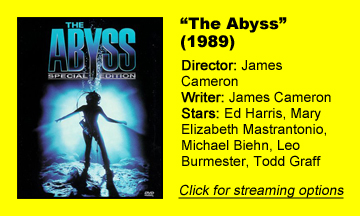“The Abyss” (1989) rarely tops rankings of James Cameron’s films, but that’s because the guy also helmed “Aliens,” “Titanic” and the first two “Terminators.” It’s no fault of “The Abyss” itself, which is a more intense, and equally beautiful, version of “2001: A Space Odyssey,” but set underwater.
Teeming with life
Whereas “2001” is a gorgeously sparse film, representing the emptiness of space, writer-director Cameron takes another tactic by making “The Abyss” very much about closely interacting human beings. It’s set in the ocean, which – as the adage goes – we know less about than outer space.
But we do know it is a place teeming with life – indeed, water is among the first building-blocks of life – so Cameron and his team craft a lively film despite (and because of) the cramped quarters of the mining habitat.
Ed Harris and Mary Elizabeth Mastrantonio, as Bud and Lindsey Brigman, have impeccable chemistry as they play out the “Aw, Look! They Really Do Love Each Other” trope of the husband and wife who are about to get divorced but are drawn back together by life-or-death stakes.
The oil-drilling crew, as would be copied by “Armageddon” nine years later, is a ragtag and loveable bunch, with nicknames such as One Night, Cat, Hippy, Jammer and Sonny. Via brief lines, facial expressions or gestures, we see the crew has sided with captain Bud – whom they work with every day – yet they also have a past relationship with Lindsey, who designed and manages the rig.
“The Abyss” gives us one intense situation after another, so even though that spiritual, mysterious alien-encounter backdrop is ever-present, not much screen time is spent on the creatures and their ships till the end.
Many iconic scenes
A mustachioed Michael Biehn has a rather thankless role as nutso Navy SEAL Coffey. We often think, “Man, as if things weren’t bad enough, they have to deal with this guy, too.”
But while Coffey might be a clichéd relic of USA-versus-Russia paranoia, the harrowing action-and-thrill pieces that result from his meddling are things we don’t often see in blockbusters – for instance, Bud free-swimming in deep and freezing water to get from one part of the craft to the moon-pool room to confront Coffey.
The thrills peak with the drowning sequence, one of the scariest non-horror sequences in movie history. It’s masterfully crafted, coming in the wake of our heroes’ victory over Coffey, when they seemingly have a moment to collect themselves before the next survival-oriented task.
As their remote submarine leaks water, the situation rapidly escalates from Bud’s “All I need is a goddamn crescent wrench” to Lindsey deciding the only option is for her to drown and Bud to later revive her back at the rig. The sequence is drenched with terror and tension no matter how many times you watch it.

We also get the gee-wiz sci-fi idea wherein you can breathe oxygenated water in order to equalize pressure and dive deeper. It’s BS but it rings true within the film’s logic, while also fitting with the theme of humanity’s core innocence: “We all breathe liquid for nine months, Bud. Your body will remember,” the SEAL’s water-breathing-system technician says.
Comparing the 2 versions
No discussion of “The Abyss” is complete without comparing the two cuts. In the 1990s, I was a proponent of the Special Edition (released in 1993, and more affordable later in the decade), because of the excitement of additional footage and a bias that Special Editions are by definition superior.
Extending the runtime from 2:20 to 2:50, the Special Edition adds a US-Russia conflict that makes Coffey seem less nuts (but more rooted in the 1980s), and it reveals that the underwater aliens are wary of humans because of this conflict, which they know about from tapping into TV feeds. Then when they see Bud’s and Lindsey’s love for each other, they befriend them.
(By the way, the underwater creatures really are space aliens, although you’d only know this by reading Orson Scott Card’s book, one of the best movie novelizations ever. But in both versions of the film, they could easily be deep-water entities we haven’t met until now.)
Today, I prefer the theatrical edition, which has the same message but portrays it in more understated and spiritual “2001”-style fashion, especially after learning that the cut was made by Cameron, who was satisfied with it.
Already renowned for “The Terminator” and “Aliens,” Cameron had final-cut rights, on the condition that the running time didn’t go much beyond 2:15.
Today, in the age of the 3-hour “Avengers: Endgame,” studios know long run times don’t hurt the box office, but in 1989 they believed they did. I’m in the minority, but I would’ve chosen the shorter version of “The Abyss” to see in theaters. That’s plenty long enough to have an epic scope.
A technical triumph
The film’s technical triumphs might be more ho-hum today, but they all still hold up, and if “Underwater” (2020) is any indication, the technology of deep-sea drilling hasn’t changed much in 31 years.
Bud, Lindsay and the crew marvel at the water tentacle along with 1989 audiences, but this makes sense in narrative terms; it’s an alien encounter, after all.
The technical aspects of “The Abyss” are amazing, including cinematography that’s clear while still communicating the dimness of the water and the dankness of the oil-drilling habitat.
It also has great sound that showcases the echoes of the clanks and clinks and drips; I remember seeing it at a friend’s house in the 1990s in the early days of home sound systems.
If it was made by a less successful filmmaker, “The Abyss” would be his crowning achievement and would be talked about more. Nonetheless, Cameron delivers a classic of deepwater thrills that won’t be surpassed.


